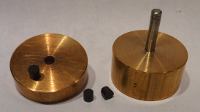Deflagration - What the powder grain does
For our purposes here, deflagration is the rate at which a flame front moves through a solid mass of propellant. Deflagration is literally a burning due to a transfer of heat in the material, which separates it from detonation, which is a chemical decomposition caused by the passage of a pressure wave through an explosive - we don't want any of that in a muzzleloader... The problem is, how does one measure how fast an individual powder grain burns, and how does this burn rate vary under different conditions (for example, in a muzzle loader charge versus in open air). There is surprisingly little information on this; Greener's book reports that powder makers would load their powder into a lead tube and then roll it into a flat strip containing a thin layer of powder. One end of the strip was lit, and the progression of the flame to the end of the strip was timed. There was only a single reference of the actual speed, which was around 2 1/4 inches/second, and although this may have been a useful measurement, I doubt how well this relates to the actual burning speed of an individual powder grain.
 To start, I wanted to find out how fast an isolated grain would burn, but even for a given granulation
size, black powder grains vary a lot, and small grains will burn up faster than larger ones. To get around
this problem, I made powder grains of exact dimensions and also large enough that the burn time could be
accurately measured. A small quantity of the candidate powder was reduced in a mortar and pestle so that the
surface graphite skin was fragmented (in those powders which were graphited,) in the presence of a tiny amount
of 100% isopropanol which acted as an aggregating agent but which would not affect the powder's
composition. The powder was then pelletized by pressing it in the die shown here at about 10,000 PSI to form a
solid mass 0.125" diameter X 0.10" long. The pellets were epoxied to a sheet of foil which was then
taped to a support so they wouldn't fly away after ignition. The top of the pellet was ignited by touching
it with the tip of a hot wire, and the burn was recorded by a Samsung TL-350 camera shooting at 120
frames/second. The frames from the start of burning to the end were counted to get a burn speed for the
powder. The results are shown below in inches/second for several powders:
To start, I wanted to find out how fast an isolated grain would burn, but even for a given granulation
size, black powder grains vary a lot, and small grains will burn up faster than larger ones. To get around
this problem, I made powder grains of exact dimensions and also large enough that the burn time could be
accurately measured. A small quantity of the candidate powder was reduced in a mortar and pestle so that the
surface graphite skin was fragmented (in those powders which were graphited,) in the presence of a tiny amount
of 100% isopropanol which acted as an aggregating agent but which would not affect the powder's
composition. The powder was then pelletized by pressing it in the die shown here at about 10,000 PSI to form a
solid mass 0.125" diameter X 0.10" long. The pellets were epoxied to a sheet of foil which was then
taped to a support so they wouldn't fly away after ignition. The top of the pellet was ignited by touching
it with the tip of a hot wire, and the burn was recorded by a Samsung TL-350 camera shooting at 120
frames/second. The frames from the start of burning to the end were counted to get a burn speed for the
powder. The results are shown below in inches/second for several powders:
| Powder | Swiss BP | Goex BP | Elephant BP | 777 | Shockleys |
| Burn Speed | xxxx | xxxx | xxxx | xxxx | xxxx |
But what about 'real' granules?
The actual granules are, of course, quite a lot smaller than these pellets, and the granules vary a LOT in size. I tried directly measuring them, both with a micrometer and with optical image measuring methods, but neither result seemed very useful considering the range of sizes. I then decided to calculate the average grain size as if each granule was a little sphere. We know this isn't true, but treating them this way might 'wash out' the variations and give a useful result, at least in terms of average burn time per granule.
To calculate this size, 'all' that was needed is the number of granules per grain of powder and the density of the powder granules (not the bulk density). I counted out about 500 granules of powder for each powder type and granulation and weighed them on a laboratory balance; this gave me the average grain weight. The density (weight/volume) was a little harder, since I needed the density of just the granules, not the air between them that one would also measure if you just saw how much volume the bulk powder filled. Our old friend Archimedes came to the rescue to help with the calculation. About 100 grains of powder was carefully weighed, and this was slowly added to a glass tube containing 100% isopropanol.
